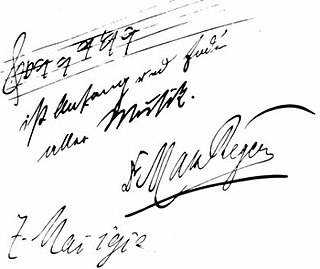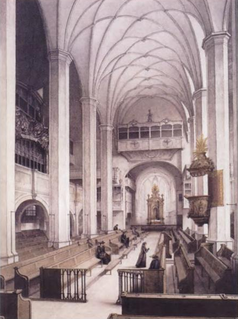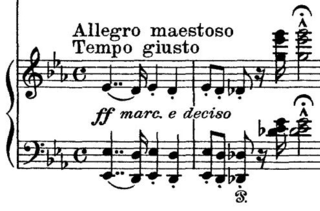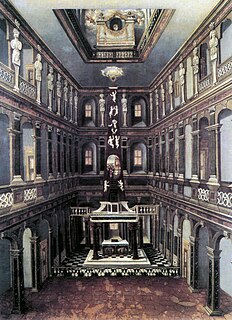
Franz Liszt was a German-speaking Austro-Hungarian composer, musician and pianist of the Romantic era.

In music, the BACH motif is the motif, a succession of notes important or characteristic to a piece, B flat, A, C, B natural. In German musical nomenclature, in which the note B natural is named H and the B flat named B, it forms Johann Sebastian Bach's family name. One of the most frequently occurring examples of a musical cryptogram, the motif has been used by countless composers, especially after the Bach Revival in the first half of the 19th century.
Hebrew cantillation is the manner of chanting ritual readings from the Hebrew Bible in synagogue services. The chants are written and notated in accordance with the special signs or marks printed in the Masoretic Text of the Bible, to complement the letters and vowel points.
Cyclic form is a technique of musical construction, involving multiple sections or movements, in which a theme, melody, or thematic material occurs in more than one movement as a unifying device. Sometimes a theme may occur at the beginning and end ; other times a theme occurs in a different guise in every part.
Cruciform is a term for physical manifestations resembling a common cross or Christian cross. The label can be extended to architectural shapes, biology, art, and design.

The Piano Sonata in B minor, S.178, is a sonata for solo piano by Franz Liszt. It was completed in 1853 and published in 1854 with a dedication to Robert Schumann.
Liebesträume is a set of three solo piano works (S.541/R.211) by Franz Liszt, published in 1850. Originally the three Liebesträume were conceived as lieder after poems by Ludwig Uhland and Ferdinand Freiligrath. In 1850, two versions appeared simultaneously as a set of songs for high voice and piano, and as transcriptions for piano two-hands.
Three Concert Études, S.144, are a set of three piano études by Franz Liszt, composed between 1845–49 and published in Paris as Trois caprices poétiques with the three individual titles as they are known today.

Ach Gott, wie manches Herzeleid, BWV 3, is a church cantata by Johann Sebastian Bach. He composed the chorale cantata in Leipzig for the Second Sunday after Epiphany and first performed it on 14 January 1725. It is based on the hymn published by Martin Moller in 1587.

Franz Liszt composed his Piano Concerto No. 1 in E♭ major, S.124 over a 26-year period; the main themes date from 1830, while the final version is dated 1849. The concerto consists of four movements and lasts approximately 20 minutes. It premiered in Weimar on February 17, 1855, with Liszt at the piano and Hector Berlioz conducting.

Weinen, Klagen, Sorgen, Zagen, BWV 12, is a church cantata by Johann Sebastian Bach. He composed it in Weimar for Jubilate, the third Sunday after Easter, and led the first performance on 22 April 1714 in the Schlosskirche, the court chapel of the Schloss in Weimar.
A Symphony to Dante's Divine Comedy, S.109, or simply the "Dante Symphony", is a choral symphony composed by Franz Liszt. Written in the high romantic style, it is based on Dante Alighieri's journey through Hell and Purgatory, as depicted in The Divine Comedy. It was premiered in Dresden in November 1857, with Liszt conducting himself, and was unofficially dedicated to the composer's friend and future son-in-law Richard Wagner. The entire symphony takes approximately 50 minutes to perform. It premiered on 7 November 1857.

Maria or Marusia Churai (1625–1653) was a semi-mythical Ukrainian Baroque composer, poet, and singer. She has become a recurrent motif in Ukrainian literature and the songs ascribed to her are widely performed in Ukraine.

Les préludes, S.97, is the third of Franz Liszt's thirteen symphonic poems. The music was composed between 1849–55, and began as an overture to Liszt's choral cycle Les quatre élémens, then revised under inspiration from the French poet Alphonse de Lamartine. Its premiere was on 23 February 1854, conducted by Liszt himself. The score was published in 1856 by Breitkopf & Härtel. Les préludes is the earliest example of an orchestral work entitled "Symphonic Poem".

Hunnenschlacht, S.105, is a symphonic poem by Franz Liszt, written in 1857 after a painting of the same name by Wilhelm von Kaulbach. Liszt conducted the premiere himself in Weimar on 29 December 1857.
Although Franz Liszt provided opus numbers for some of his earlier works, they are rarely used today. Instead, his works are usually identified using one of two different cataloging schemes:

Holy Mother of God Church, sometimes known as Yeghvard Church, is a medieval Armenian church located at the center of Yeghvard in the Kotayk Province of Armenia. It was completed in 1301 during the rule of the Zakarid dynasty. It was built and completed as an alternative church of the nearby ruined Katoghike Church, a large three-nave basilica dating back to the 5th and 6th centuries.
Hungarian Rhapsody No. 8, S.244/8, in F-sharp minor, is the eighth Hungarian Rhapsody composed by Franz Liszt for solo piano. It was composed in 1847 and published in 1853. It has been nicknamed "Capriccio". It utilizes a melody of Hungarian folk song Káka tövén költ a ruca in the slow section. The allegro motif was also used by Liszt in his symphonic poem Hungaria (1856).

Signum manus refers to the medieval practice, current from the Merovingian period until the 14th century in the Frankish Empire and its successors, of signing a document or charter with a special type of monogram or royal cypher.

"Erlkönig", Op. 1, D 328, is a Lied composed by Franz Schubert in 1815, which sets Johann Wolfgang von Goethe's poem of the same name. The singer takes the role of four characters — the narrator, a father, his small son, and the titular "Erlking", a supernatural creature who pursues the boy — each of whom exhibit different tessitura, harmonic and rhythmic characteristics. A technically challenging piece for both performers and accompanists, "Erlkönig" has been popular and acclaimed since its premiere in 1821, and has been described as one of the "commanding compositions of the century".

 Play (help·info).
Play (help·info).










